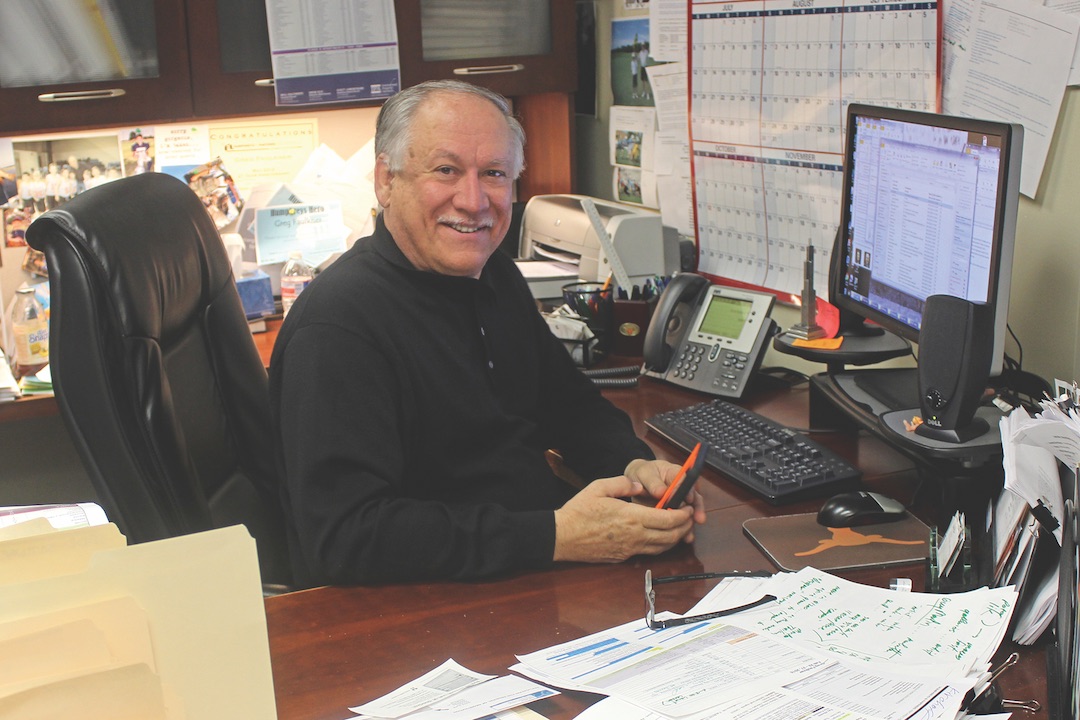Legend has it that Mark Humphreys won his first design award while still a student at Dallas’s W. T. White High School. The winning entry was a home he designed for a district-wide competition. As an architecture student at Texas Tech in the mid-1970s, he took a part-time job designing apartment buildings for a local developer in Lubbock. It didn’t take him long to figure out that he could do the same work on his own. Before you could say “Go Red Raiders,” he had a posse of other Texas Tech architecture students punching out residential designs for his own business.
After earning his architecture degree in 1978, Humphreys had stints at various firms in Lubbock before moving to Dallas in 1989. There he worked with Greg Faulkner, a University of Texas–trained architect who had experience working for a developer in Memphis. Two years later, in defiance of the horrific recession that was paralyzing the U.S. economy, they launched Humphreys & Partners Architects.
With the recession in full swing, 1991 was hardly the best time to roll out any business, no less an architecture firm. Skilled professionals were being laid off right and left; a whole generation of architects would be lost during this period. “There wasn’t much multifamily work at the time, so we started with a few single-family housing projects and built from there,” said Faulkner, HPA’s President.
Those lean years reinforced the importance of viewing each project as an opportunity to build long-term client relationships. “We don’t look at any client as a one-time client; we want to do their next 10 projects,” said Faulkner. “That’s really how we’ve grown the firm.”
See Also: The latest data in the multifamily ‘amenities war’
Market-rate apartments are HPA’s bread and butter. Its work ranges from low-rise suburban buildings to towering urban structures. About half of HPA projects also integrate mixed-use components, whether that’s a sandwich shop or a large-scale retail and entertainment component.
HPA, which reported $78.2 million in multifamily design fees in 2017, ranks as the nation’s largest multifamily design firm. CEO Humphreys estimates the firm designs 12–15% of all apartments built in the U.S. That would represent more than 50,000 units last year.
POWERED BY ENTREPRENEURSHIP
The entrepreneurial spirit is deeply embedded in HPA’s culture. This force has guided the development of a half-dozen trademarked “signature designs” that improve the performance and efficiency of multifamily projects.
Humphreys devised the first of these innovations in 1995. “Big House” is a two-story apartment structure that combines elements of a townhouse and a single-family home, including direct-access garages and private entrances. Because the structure looks more like an upscale single-family home than a typical apartment building, the concept been welcomed in many suburban residential neighborhoods. HPA has designed more than 300 Big House projects throughout the U.S.
HPA introduced the “e-Urban” concept in 2007, in response to skyrocketing construction costs. The design replaces the long hallways of mid-rise apartment buildings with short corridors and elevators, delivering an efficiency ratio of more than 80%, compared to about 60% for typical mid-rise designs. It’s also less expensive to build.
Although multifamily work accounts for about 80% of HPA’s current portfolio, the firm also has significant experience in student residential, senior housing, and hospitality projects.
HPA approaches each project with a developer’s mindset. The firm focuses on the factors that help boost net operating income, such as location, walkability, proximity to parks and marketplaces, and attractive streetscapes. “We’re not just drawing up plans; we really engage with our clients to understand all of the economic factors of a project,” said Faulkner.
To help its clients position their businesses for the future, the firm hosts periodic online webinars and conducts ongoing research to identify demographic, lifestyle, and industry trends. “Anticipating needs is one of the things our clients appreciate most about us, because it contributes to a higher return on investment,” said Humphreys.

HPA Co-founder Greg Faulkner
AN EVER-EXPANDING FOOTPRINT
Strong global demand for multifamily units has fueled a period of unprecedented growth for HPA. “Over the last eight to 10 years, multifamily rental housing has been the center of the universe, and we’ve been riding that wave,” said Faulkner.
Humphreys and Faulkner have never been shy about their growth ambitions. Geographic expansion began in 1998 with the opening of an office in Orlando, Fla. HPA established a West Coast presence in 2005 in Newport Beach, Calif. The firm has grown its U.S. footprint to include offices in Charlotte, Chicago, Denver, Houston, Los Angeles, New Orleans, New York, and Scottsdale, Ariz.
Outside the U.S., HPA has expanded into regions with pent-up multifamily demand. Montevideo, Uruguay, was the site of the first international office, in 2011. The firm now operates a global network with additional offices in Chennai (India), Hanoi and Ho Chi Minh City (Vietnam), and London.
‘We’re not just drawing up plans. We really engage with our clients to understand all the economic factors of a project.’
—Greg Faulkner, AIA, NCARB
Demographic shifts, including downsizing Baby Boomers and Millennials who are drawn to high-density areas, continue to drive market demand for rental units. Those trends have helped grow the number of full-time HPA employees to 342, a 95% increase in employment over the last five years. “We don’t turn down work. We hire people, create jobs, and grow the company,” said Humphreys.
To distinguish the firm as an employer of choice in the current tight labor market, HPA positions itself as an energetic culture that encourages creativity and innovation, but with a strong business sense. “We’re not running an art gallery; we’re running a profit center—and we’re proud to share those profits with our employees,” said Faulkner.
The founders—both of whom are AIA and NCARB members—are committed to nurturing the next generation of architects at their respective alma maters. In 2015, Humphreys donated $1.5 million to Texas Tech University College of Architecture—the college’s largest one-time gift—to establish the Mark E. Humphreys AIA Chair in Urban Design. This endowed faculty position supports ongoing research in sustainable, engaged models of urban design. Faulkner has been instrumental in establishing two academic scholarships at the University of Texas at Austin School of Architecture.
BROADENING THE FIRM’S EXPERTISE
HPA has expanded its in-house expertise by establishing several complementary business units: HPA Design Group, an interiors practice; HPLA, a landscape architecture studio; HP Urban, which specializes in planning and design for high-density projects; HP Civil Engineering; and Atticus Real Estate, the company’s real estate investment and development arm.
Two other HPA businesses fall squarely outside the domain of a traditional design firm. Glass Recycled Surfaces, a manufacturing company that Humphreys purchased in 2013, repurposes glass bottles and porcelain fixtures into countertops, flooring, and wall applications. PiaggioCharter.com offers private air transportation, leasing, and charter services from its base at Addison Airport in suburban Dallas. The business is a deeply personal passion for Humphreys, whose father was a lead designer on the original Lear Jet Model 23. Humphreys earned his pilot’s license in 2007.
At times, HPA has ventured even further from its multifamily base to flex its design chops. Vice President of Design Walter Hughes recently conceptualized two urban skyports for electric-powered vertical take-off and landing aircraft (commonly known as eVTOLs). Last May, HPA’s concept was named one of six finalists at the second annual Uber Elevate Summit. “We’re always searching out new ways to expand the connective tissue between our multifamily residences and emerging disruptive technologies,” said Humphreys.
HPA’s founders are grateful for their success. “Twenty years ago, Mark and I would’ve cut off our right arms to be doing everything we’re doing right now,” said Faulkner. “We need to knock on wood every day because we’ve been very, very fortunate.”
Related Stories
Giants 400 | Feb 9, 2023
New Giants 400 download: Get the complete at-a-glance 2022 Giants 400 rankings in Excel
See how your architecture, engineering, or construction firm stacks up against the nation's AEC Giants. For more than 45 years, the editors of Building Design+Construction have surveyed the largest AEC firms in the U.S./Canada to create the annual Giants 400 report. This year, a record 519 firms participated in the Giants 400 report. The final report includes 137 rankings across 25 building sectors and specialty categories.
Multifamily Housing | Feb 7, 2023
Multifamily housing rents flat in January, developers remain optimistic
Multifamily rents were flat in January 2023 as a strong jobs report indicated that fears of a significant economic recession may be overblown. U.S. asking rents averaged $1,701, unchanged from the prior month, according to the latest Yardi Matrix National Multifamily Report.
Giants 400 | Feb 6, 2023
2022 Reconstruction Sector Giants: Top architecture, engineering, and construction firms in the U.S. building reconstruction and renovation sector
Gensler, Stantec, IPS, Alfa Tech, STO Building Group, and Turner Construction top BD+C's rankings of the nation's largest reconstruction sector architecture, engineering, and construction firms, as reported in the 2022 Giants 400 Report.
Multifamily Housing | Feb 3, 2023
HUD unveils report to help multifamily housing developers overcome barriers to offsite construction
The U.S. Department of Housing and Urban Development, in partnership with the National Institute of Building Sciences and MOD X, has released the Offsite Construction for Housing: Research Roadmap, a strategic report that presents the key knowledge gaps and research needs to overcome the barriers and challenges to offsite construction.
Multifamily Housing | Feb 2, 2023
St. Louis’s first transit-oriented multifamily development opens in historic Skinker DeBaliviere neighborhood
St. Louis’s first major transit-oriented, multi-family development recently opened with 287 apartments available for rent. The $71 million Expo at Forest Park project includes a network of pathways to accommodate many modes of transportation including ride share, the region’s Metro Transit system, a trolley line, pedestrian traffic, automobiles, and bike traffic on the 7-mile St. Vincent Greenway Trail.
Multifamily Housing | Feb 1, 2023
Step(1) housing: A new approach to sheltering unhoused people in Redwood City, Calif.
A novel solution to homelessness will open soon in Redwood City, Calif. The compact residential campus employs modular units to create individual sleeping units, most with private bathrooms. The 240 units of housing will be accompanied by shared services and community spaces. Instead of the congregate dorm-style shelters found in many U.S. cities, this approach gives each resident a private, lockable, conditioned sleeping space.
Multifamily Housing | Jan 24, 2023
Top 10 cities for downtown living in 2023
Based on cost of living, apartment options, entertainment, safety, and other desirable urban features, StorageCafe finds the top 10 cities for downtown living in 2023.
Multifamily Housing | Jan 23, 2023
Long Beach, Calif., office tower converted to market rate multifamily housing
A project to convert an underperforming mid-century office tower in Long Beach, Calif., created badly needed market rate housing with a significantly lowered carbon footprint. The adaptive reuse project, composed of 203,177 sf including parking, created 106 apartment units out of a Class B office building that had been vacant for about 10 years.
Multifamily Housing | Jan 19, 2023
Chicago multifamily high-rise inspired by industrial infrastructure and L tracks
The recently unveiled design of The Row Fulton Market, a new Chicago high-rise residential building, draws inspiration from industrial infrastructure and L tracks in the historic Fulton Market District neighborhood. The 43-story, 300-unit rental property is in the city’s former meatpacking district, and its glass-and-steel façade reflects the arched support beams of the L tracks.
Multifamily Housing | Jan 19, 2023
Editorial call for Multifamily Affordable Housing project case studies - no cost to submit!
Building Design+Construction will feature a roundup of "Multifamily Affordable Housing" projects on BDCnetwork.com.

















